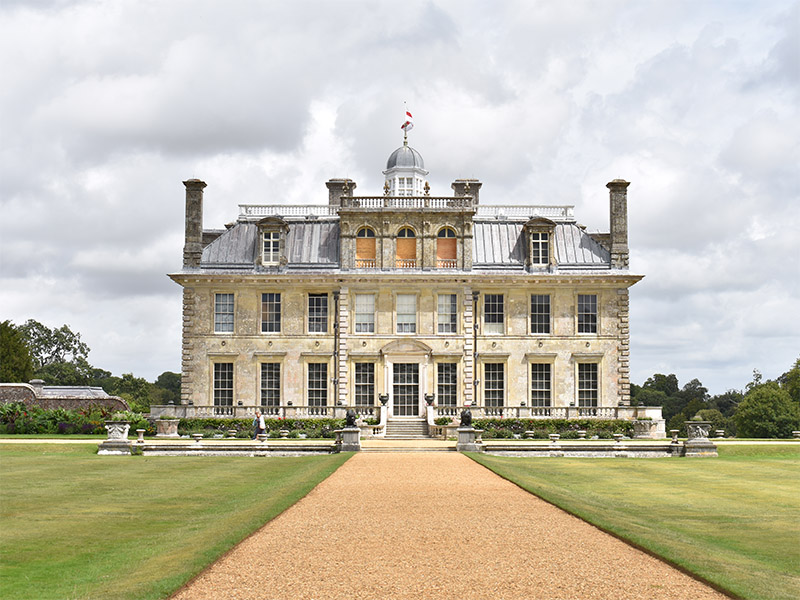
Lauren Cochrane reports on her SWWDTP-funded placement: an investigation into colonial activities of the Woodley family in the 18th century.
Having just completed a three-month placement with the National Trust at their Kingston Lacy property, I have unearthed new historical insights into the colonial connections and legacies at this country house. The project focused on the life of Frances Woodley (1760-1834), who arrived at Kingston Lacy after her marriage to Henry Bankes II the Younger in August 1784. The stimulus for the project, was the the restoration of Frances’ portrait by George Romney, and intended to investigate how the renovations to Kingston Lacy which took place in the 1780s were financed.

Portrait of Frances Woodley by George Romney
The colonial connections of the Woodley family are strong, as Frances’ father, William Woodley (1728-1793) was Governor of the Leeward Isles and owned sugar plantations in St Kitts. Similarly, Frances’ brother, William Woodley (1762-1810) would go on to become Lt. Governor of Berbice and inherited his father’s sugar plantations.
This project aimed to contextualise the Woodley family in British society, to better understand their colonial activity, and to see if I could find concrete evidence that Frances’ £6,000 dowry financed renovations made to Kingston Lacy in the 1780s.
While I was unable to find concrete evidence that France’s dowry paid for material changes made to the Kingston Lacy property, an analysis of archival files strongly suggests that this was the case. There is no record of the dowry’s utilisation for any purpose in Henry Bankes’ personal accounts.
However, archival documents indicate that renovations to the house were ramped up after Henry and Frances’ marriage. My research highlighted therefore that the money spent on renovations to Kingston Lacy, which is labelled as “new work” in household accounts and receipts, increased dramatically in the first few years of Henry and Frances’ marriage. While it is disappointing to be unable to unquestionably say whether the dowry financed the renovations, further study of the Woodley family has unveiled new insights into their colonial connections.

Kingston Lacy country house
The exact number of Caribbean plantations owned by William Woodley is unclear, however four estates are continuously referenced in archival sources. British slave registers indicate how many enslaved people were employed on the Woodley estates in the years 1813-1834. For example, in the year 1817, when the Needsmust Estate had been inherited by Frances’ nephew, the enslaved population of this estate was 140.
While this date range surpasses the life of Frances’ father, the inheritance of the estates by Frances’ brother, and then her nephew – both also named William Woodley, indicates how the Woodley families continued to reap the financial benefits of the trans-Atlantic slave trade. Frances’ significant dowry was facilitated by years of inherited wealth accumulated from colonial exploitation. While she had no direct hand in this, the believed utilization of her dowry to make material changes to Kingston Lacy permanently links the property to the labours of enslaved people in the Caribbean.
The research also revealed that William Woodley was Governor of the Leeward Isles during the thwarted Montserrat Slave Rebellion of March 1768. On 17th March 1768 – St Patrick’s Day – enslaved and free Black Montserratians concocted a plan to overthrow the island’s elite. Domestic slaves planned to obtain the weapons of the planter elite as they entered Government House to celebrate the holiday, where upon a signal, the room would be seized by the rebels who would murder anyone who tried to escape.
The plans were halted after a drunken woman overheard the plans and warned government officials. Seven of the ringleaders of the plot were executed with British and American newspapers reporting that the convicts were subjected to tortures including quartering and being broken on the wheel. As governor, William Woodley would have had to sanction this punishment thus linking the Woodley family, and therefore the Kingston Lacy property to British colonial violence in the age of empire.
This project has unearthed new insights into the life of Frances Woodley and her family. It has also highlighted the potential future research opportunities available to the Kingston Lacy team – who are considering embarking on a larger collaborative PhD project in future. But, it is important to recognize the material connections that the Kingston Lacy property has with the trans-Atlantic slave trade and the British empire. Money obtained from colonial economies of slavery helped to refurbish the Bankes family home in ways that are still visible.
Crucially, the research now affords the National Trust the opportunity to engage in public discussions about the colonial legacies of its properties and offer a more nuanced and informed public history of the Kingston Lacy property to recognize the legacies of colonialism in Britain’s built heritage. Such an opportunity means efforts must be made to interpret and present this new knowledge to public audiences in a sensitive and self-aware manner, recognizing the potential sensitivities stemming from this subject matter.

Lauren Cochrane at Kingston Lacy
Going forward, I will be working with the Kingston Lacy team on their public interpretation of these colonial histories, working collaboratively to produce a public history which fully recognizes the material legacies of the British empire in Britain’s heritage sector today.
Categorised in: Student Blogs